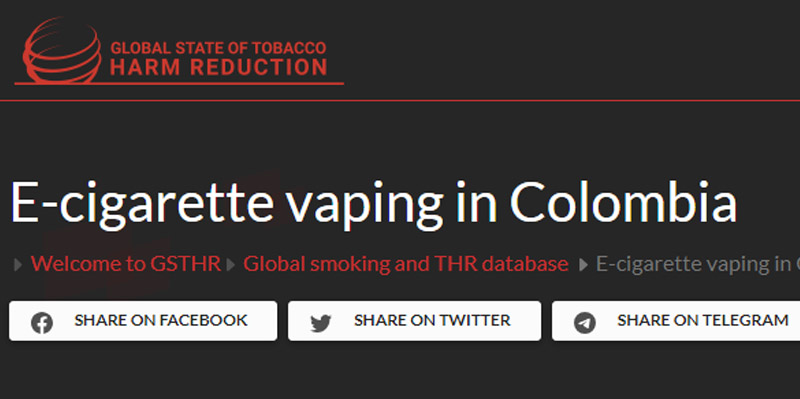Summary of the E-cigarrette Laws in Colombia
Product promotion
Ban on all advertising:YES. Banned at place of sale and banned in all media.
Advertising is regulated:YES. Allowed or banned at place of sale or allowed or banned in all media.
Regulation
Regulated as tobacco product:YES
Other options for purchasing - where bans in place:YES
References:
Data cross-referenced where possible using the following sources :
1. Vapetrotter website. Available at: https://www.vapetrotter.com/laws/ ;
2. Global tobacco control website. Available at:https://www.globaltobaccocontrol.org/node/14052 ;
3. Tobacco Control Laws website. Available at : https://www.tobaccocontrollaws.org/legislation/
Availability
Legal to purchase without prescription:YES
Products are marketed:YES
Information gathered from personal contact with users in the region.
Regulations and restrictions
Legal restrictions on use in public places:YES

A Comprehensive Overview of Regulation and Impact of Vape Laws in Colombia:
In recent years, the vaping industry has gained significant attention globally, and Colombia is no exception. As governments strive to strike a balance between public health concerns and individual freedoms, Colombia has implemented a series of laws and regulations surrounding vaping products. This article provides a comprehensive overview of the vape laws in Colombia based on information sourced from reputable references such as the Vapetrotter website, Global Tobacco Control website, and Tobacco Control Laws website, as well as insights from personal contact with users in the region.
Product Promotion: Stricter Measures for Public Health
Colombia has taken a robust stance against the promotion of vaping products, with a complete ban on all forms of advertising. This ban encompasses both the place of sale and all media outlets. The Colombian government has deemed the promotion of vaping products to be detrimental to public health, given the potential risks associated with vaping, particularly among the youth. As a result, not only is advertising banned at points of sale but also across all media platforms. This stringent approach aims to minimize the allure of vaping to younger demographics and prevent the normalization of its use.
Regulation: Treating Vaping as Tobacco
Colombia classifies vaping products as tobacco products, subjecting them to similar regulatory frameworks. This categorization serves to ensure that vaping products are held to the same standards as traditional tobacco products, reinforcing the government's commitment to safeguarding public health. Additionally, even in cases where bans on tobacco products are in place, vaping products are subject to similar restrictions. This alignment highlights the authorities' intention to address vaping's potential health implications with the same seriousness as traditional smoking.
Availability: Balancing Accessibility and Responsibility
Despite the stringent regulations, vaping products are legally available for purchase in Colombia without a prescription. This accessibility is in line with consumer freedom; however, it also raises concerns about the potential misuse of these products, especially among vulnerable populations. The fact that vaping products are marketed and sold suggests that there is a demand for these alternatives to traditional smoking. It is essential for the government and relevant authorities to strike a balance between accessibility and responsible usage to ensure public health and safety.
Regulations and Restrictions: Curbing Public Vaping
In a bid to protect the public from potential health risks and secondhand exposure, Colombia has implemented legal restrictions on vaping in public places. This regulation ensures that vaping is treated similarly to smoking in terms of public conduct. By prohibiting vaping in public areas, the government aims to reduce the normalization of vaping behavior and its potential impact on bystanders, particularly in enclosed spaces.

Conclusion
Colombia's approach to regulating vaping products reflects a commitment to public health and the responsible management of potentially harmful products. The comprehensive ban on advertising, along with the classification of vaping products as tobacco, underscores the government's dedication to addressing vaping's potential risks. While maintaining the availability of vaping products without a prescription allows for consumer choice, the legal restrictions on public vaping underscore the importance of protecting the general population from potential health hazards. As the vaping landscape continues to evolve, Colombia's vaping laws are likely to adapt to new evidence and changing societal perspectives, further emphasizing the government's dedication to striking the right balance between public health and individual freedoms.
Impact and Future Considerations
The implementation of stringent vaping regulations in Colombia has undoubtedly had a significant impact on the vaping industry and public health. By banning advertising and regulating vaping products as tobacco, the government has taken proactive steps to mitigate the potential risks associated with vaping, especially among young individuals who might be enticed by marketing campaigns. The alignment of vaping regulations with tobacco restrictions reflects a holistic approach to safeguarding public health, ensuring that all nicotine-containing products are subject to the same level of scrutiny.
However, as with any evolving regulatory landscape, challenges and considerations remain. One key consideration is the continuous monitoring of vaping-related research and developments. As new evidence emerges about the long-term effects of vaping and its potential health risks, regulatory bodies in Colombia must remain adaptable and open to revisiting existing regulations to ensure they align with the most current scientific understanding.
Furthermore, while the ban on advertising is an important step, education and awareness campaigns should be employed to ensure that the public, especially the youth, fully comprehend the potential risks associated with vaping. A comprehensive approach to vaping regulation includes not only restricting promotion but also empowering individuals with knowledge to make informed decisions about their health.
In the future, Colombia may face the challenge of balancing its commitment to public health with the evolving preferences of consumers. As vaping technologies advance and potentially offer less harmful alternatives to traditional smoking, regulators will need to assess whether adjustments to the current regulations are necessary to accommodate these changes while still prioritizing public health and safety.
Colombia's vaping regulations exemplify a proactive approach to addressing the complexities of the vaping landscape. By banning advertising, classifying vaping products as tobacco, and implementing restrictions on public usage, the Colombian government has demonstrated its dedication to preserving public health. The regulations seek to strike a balance between individual freedoms and safeguarding the well-being of its citizens.
As the global understanding of vaping's impact evolves, Colombia's regulations are likely to evolve as well. It is essential for stakeholders to continue collaborating, incorporating new research findings, and adapting regulations to align with emerging scientific knowledge. Through a combination of responsible regulation, public education, and ongoing vigilance, Colombia aims to navigate the dynamic landscape of vaping in a way that ensures the health and safety of its population.
